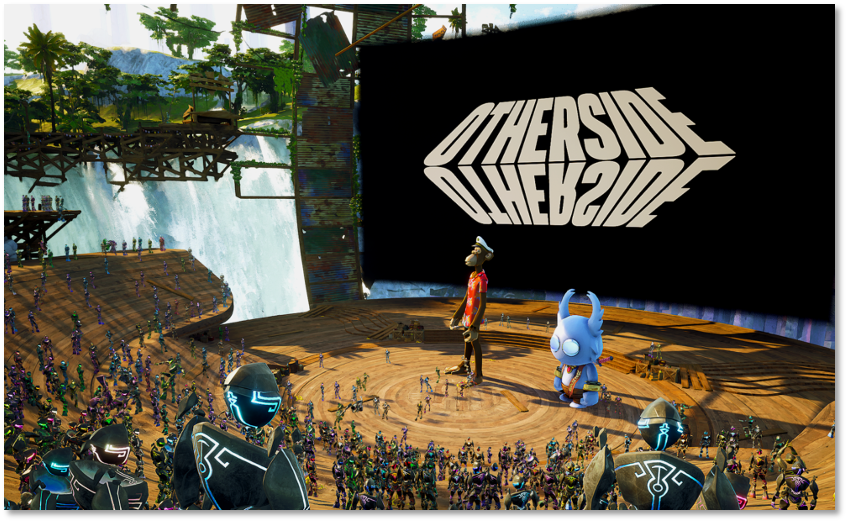Game Revelation of the Whole Chain A Comparison of the Value Chains of Web2 and Web3 Games
Comparison of Web2 and Web3 GamesAuthor: @Minta, PSE Trading Analyst
TL;DR
Basic Concepts and Significance of Full-chain Games
Value Chain Breakdown – Web2 Game Value Chain VS Web3 Game Value Chain
- Intent-centric Narrative Outlook Unlocking New Scenarios for Cryptographic Applications
- Under the narrative of re-collateralization, how to value EigenLayer?
- zkSci How is zero-knowledge proof applied in scientific research?
Infrastructure Layer – Game Public Chain, Game Engine, Communication Structure, Rendering Layer, etc.
Middleware – SDK Integration, Service Integration, Communication Protocols, Monitoring Tools, etc.
Distributors – Analysis of Different Distribution Strategies and Case Studies
01 Overview
A full-chain game refers to a game that stores game logic and data entirely on the blockchain, and relies on smart contracts to run and interact. In contrast, a partial-chain game refers to a game that only stores some game elements on the blockchain. Depending on the content stored on-chain, partial-chain games can be further divided into core logic on-chain, asset on-chain, achievement on-chain, and interaction on-chain.

Core logic on-chain generally refers to storing the game’s algorithms and core data on the blockchain. For example, in a game of chess, the basic rules of chess are stored on-chain, and the status of the chessboard and all core data related to the game process are recorded on the blockchain. Every move of the chess piece and the determination of victory or defeat are carried out on the blockchain through smart contracts. Asset on-chain refers to placing virtual items, characters, or other resources within the game on the chain, allowing players to fully own, trade, and manage these assets, providing economic benefits to players, incentivizing their participation in the game ecosystem, and opening up possibilities for an open economy.
Achievement on-chain is also an interesting concept. The achievements of players in the game can be recorded on the blockchain as their glorious records in the game world. This allows players’ achievements to be recognized not only within the game but also on the chain.
Expanding further, we have interaction on-chain. This includes not only the achievements of players but also their interaction records within the game community, such as chatting with other players, participating in community activities, etc. These are all recorded on the chain, like an interesting game resume, giving meaning to every participation of players.
Of course, full-chain games are still a new concept and are currently in the early stages of development. It is clear that by abstracting various modules of the game and placing them on the blockchain, more possibilities for innovation are created. However, the specific impact of fully migrating the game to the blockchain is still being explored in the industry. From a qualitative analysis perspective, the most compelling reasons for why the entire game should be migrated to the blockchain can be summarized as follows:
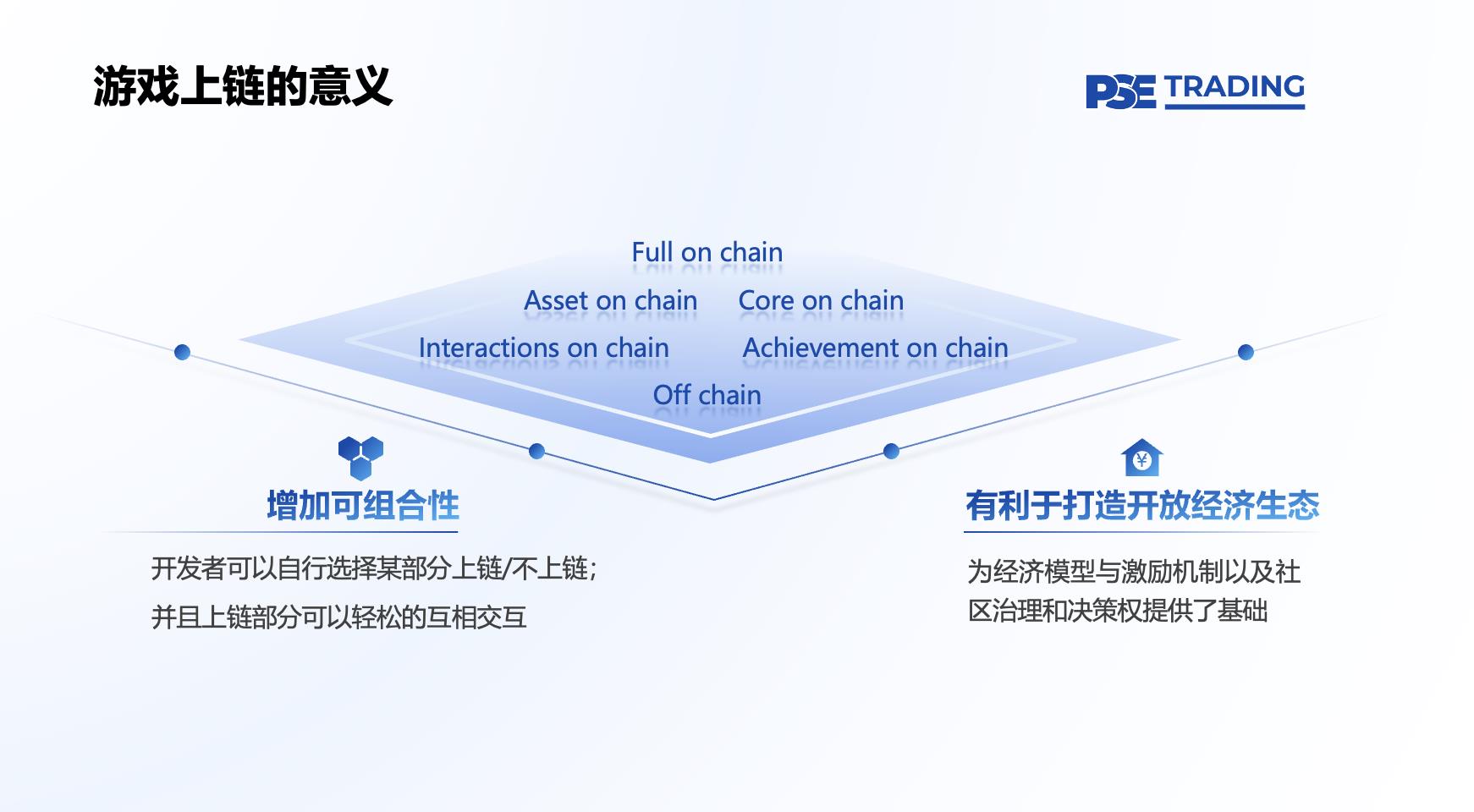
Increased composability:
Build more game modules through smart contracts, including security audits, access control, and resource measurement, etc. Traditional games are difficult to adapt to this environment and recombine around composable modules. At the same time, smart contracts can also be used to create more UGC (User Generated Content) modules, thereby reducing the threshold for game content production, promoting UGC creation, and enhancing the playability and composability of the game.
Open economy:
With the increasing number of Web3 players and the enhanced interoperability of various ecosystems, the game economy becomes more open, allowing players to participate in in-game economic activities in a more flexible manner.
PSE Trading’s follow-up articles in the same series will discuss the rationality of on-chain games in more detail. This article focuses on the concept of the full-chain game and presents a panoramic view of the value chain, aiming to provide readers with a clearer understanding of each link in the full-chain game industry chain.
02 Value Chain
2.1 Web2 Game Value Chain
When discussing the value chain of the Web3 game industry, we can learn from the experience of the Web2 game industry. The Web2 game industry can be roughly divided into four key layers: infrastructure layer, middleware layer, service layer, and application layer.
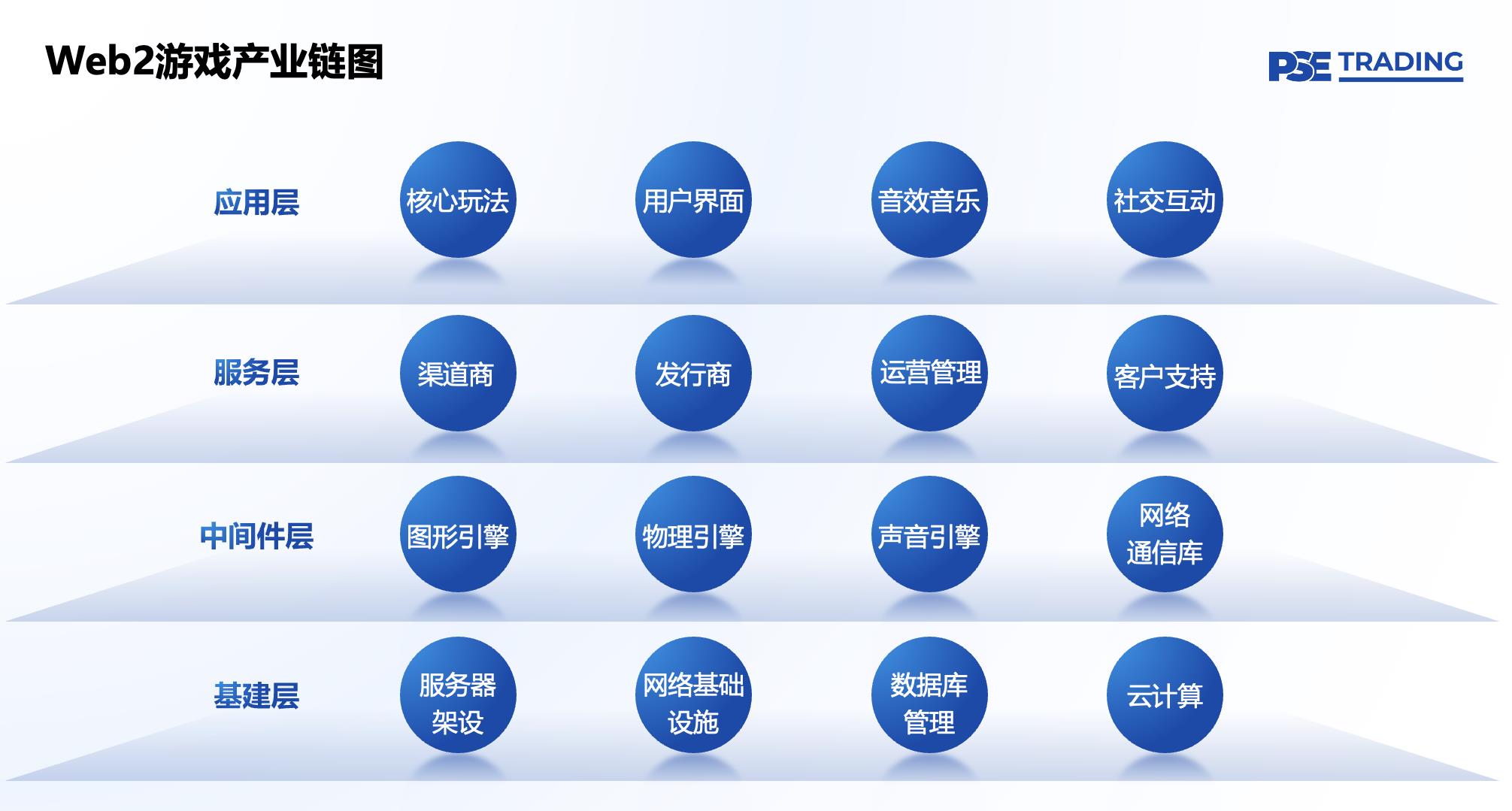
The infrastructure layer is the foundation of the entire game ecosystem, which covers the basic infrastructure and key technologies necessary for building the game operating environment. For example, games need to run on servers, and services like Amazon Web Services (AWS) and Microsoft Azure provide the infrastructure for server deployment. Network infrastructure, mainly used for online functions in games, such as network hosting services, etc.
The middleware layer mainly focuses on solving the technical complexity in the game development and operation process. For example, the graphics engine is responsible for handling game graphics rendering, presenting players with beautiful game scenes. The physics engine can be used to simulate the physical behavior of objects in the game, adding a more realistic interactive experience to the game; for example, Havok and PhysX are well-known physics engines that inject vivid elements into the physical effects in the game.
The service layer is responsible for multiple key processes between the game and end users. This includes game distribution, operation, customer support, and terminal services, etc. Taking distribution as an example, channel providers play an important role in introducing games to the market and ensuring that games reach a wide range of players. In terms of operation, various market strategies and promotional activities are implemented at this level to ensure the visibility and attractiveness of the game.
The application layer is the core content and user interaction that the game presents to the players. At this level, the core gameplay, graphics interface, sound effects, music, and social interaction of the game are displayed.
In summary, the value chain of traditional Web2 games is interconnected, from infrastructure and technical middleware to game application design. However, as a highly industrialized track, the value chain of Web2 games is finely divided, with specific tools/teams for each scenario/requirement. By drawing on the value chain of Web2 games, we can better understand the composition of the Web3 game ecosystem.
2.2 Web3 Game Value Chain
Compared to the maturity of the Web2 game track, the full-chain game field is still in the early stages of development. Therefore, the granularity of the full-chain game industry chain is not as fine as that of Web2 games. However, the relationship between the upstream and downstream of the full-chain game industry chain still follows a similar logic to the Web2 game industry chain.
The full-chain game industry chain can still be divided into four key levels, corresponding to the levels in the Web2 game field: infrastructure layer, middleware layer, service/tool layer, and application/game layer.
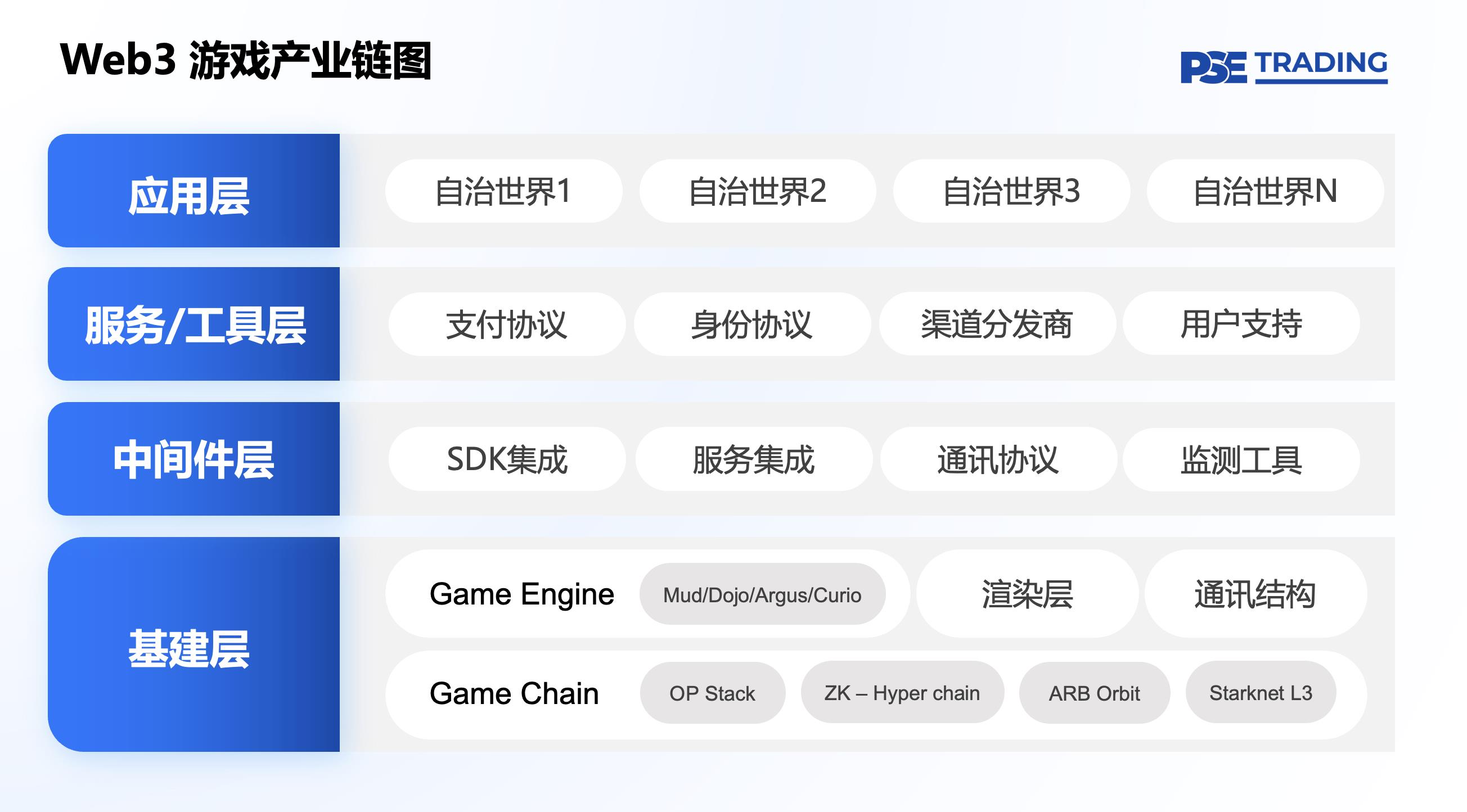
03 Infrastructure Layer
In the game industry, the infrastructure layer is like a solid pillar. From server operations to network connections, and player data management, the various components of the infrastructure layer collectively build the virtual world of the game.
As mentioned earlier, the biggest difference between Web3 and Web2 games is that Web3 full-chain games involve on-chain activities. At the same time, in the on-chain game ecosystem, the biggest network effect comes from the composability and scalability of the game, as well as the combination of game assets with other games based on the same ecosystem and engine. Therefore, in the infrastructure of Web3 full-chain games, two very important components are the public chain tailored for games and the on-chain game engine built for scalability.
3.1 Game Public Chains
Currently, there are mainly two types of public chains related to games. One is Layer2 chains specifically designed for games, and the other is Layer1 chains that encourage game ecosystems. This article lists some examples below:
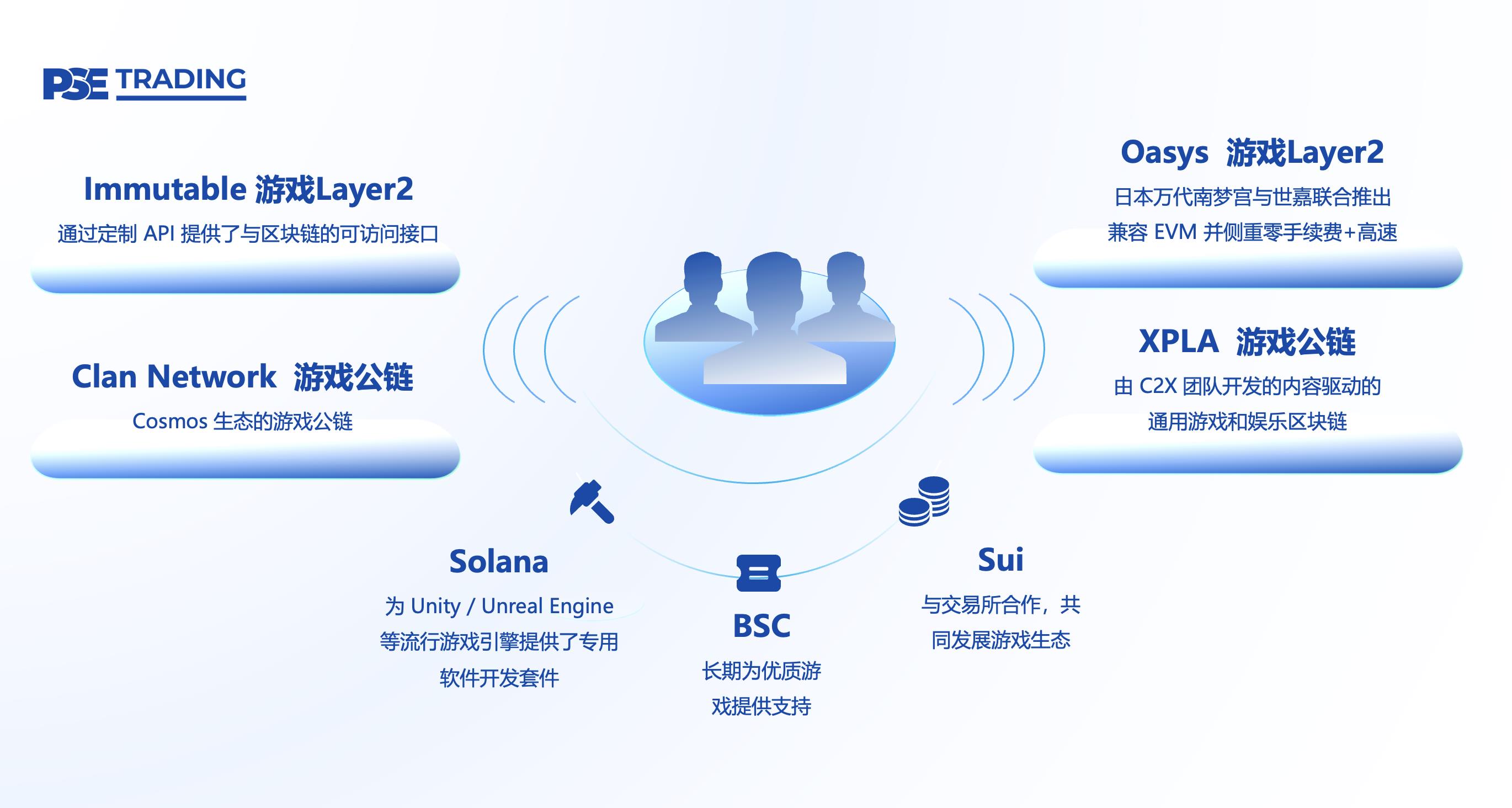
From a data perspective, according to Footprint’s data, BNB Chain, Ethereum, Polygon, and Wax are still leading in the GameFi field, with over 80% of on-chain games deployed on them.

Referring to Footprint’s monthly on-chain game transaction data (note: data is up to August 2023), the Wax ecosystem has maintained an absolute leadership position in transaction volume in 23. As of the time of writing, the transaction volume of Wax in August 23 was 429.24M, accounting for 86.56% of all game transactions on the chains.

According to the annual transaction data of the Footprint blockchain game (note: the data is up to 2023), Wax has occupied the absolute position in terms of transaction volume since 2020, and there has been no significant change in the ranking of blockchain game transaction volume during this period.
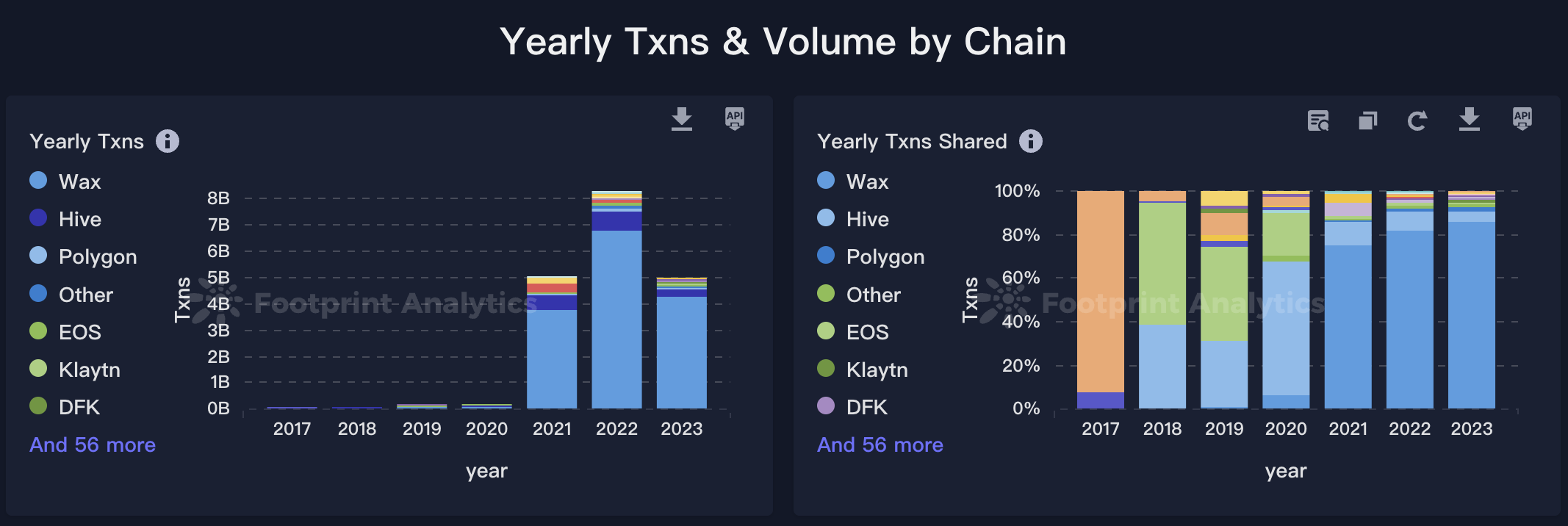
3.2 Game Engines
Many codes and graphic materials used in game development can be reused. Therefore, game developers integrate most of the code and assets required by games into a set of development tools (SDK) to improve development efficiency and optimize the development process. This set of SDK is called a game engine.
For example, Unity provides developers with rich tools and resources, allowing them to create 2D and 3D games. Another example is Unreal Engine, which is very powerful in graphics rendering and special effects, and is widely used in the development of high-quality AAA games.
Some Web 3 game studios, such as Planetarium Labs and Lattice, are also developing their own Web 3 game engines, allowing Web3 game developers to write complex game logic and interactive content.
According to the summary of Web3 Game Engines by IOSG Ventures – Ishanee, Mud and Dojo are public products, while Argus and Curio are built by past commercial teams through fundraising:

In summary, the functions of the four Game Engines compared by IOSG Ventures – Ishanee are as shown in the following figure:
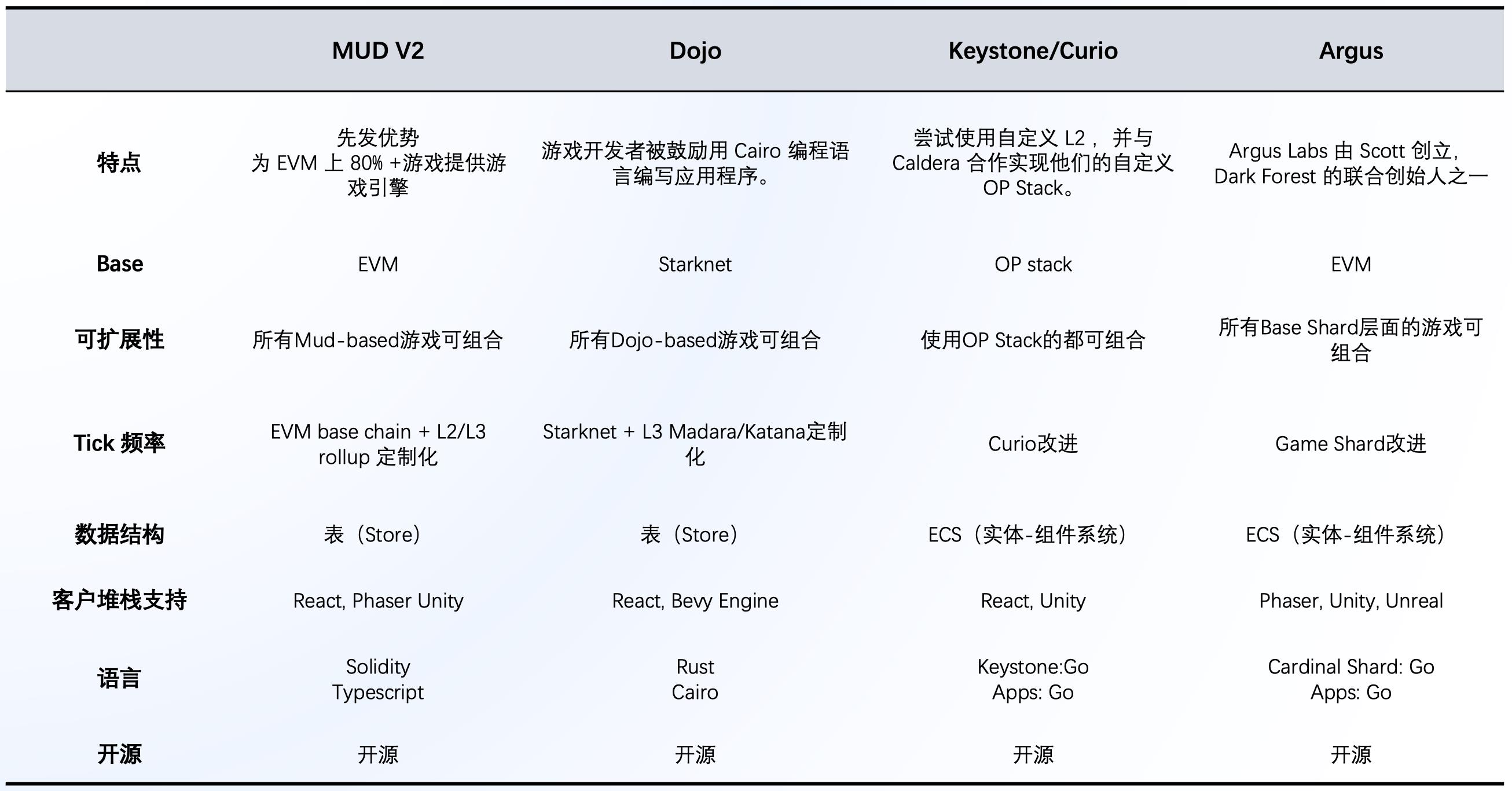
Among them, MUD is the pioneer of Web3 game engines, with a first-mover advantage and a large player community. Curio’s keystone is also building a game design engine, focusing on increasing the ticks of the blockchain. Argus focuses on various extension solutions and building different frameworks for game design. Dojo focuses on building a game where all logic can be proven to have been executed off-chain.
In addition to the engines themselves, there are also tools that focus on building specific modules, such as:
Endless Quest: Generates consistent narratives in AW, such as metadata and artwork.
MUDVRF: A MUD module that generates on-chain random numbers in the game.
DeFi Wonderland: Account management module using a burner client to access wallet accounts.
MUD Scan: Leaderboard for MUD games.
Argus: Also plans to launch an EVM Layer 2 with insertable data availability layer, with customizability as the core.
Among them, MUD v2 and Dojo are two engines with faster development progress. Several full-chain games using MUD and DOJO have been launched, and this article summarizes them. Please see the table below for details.

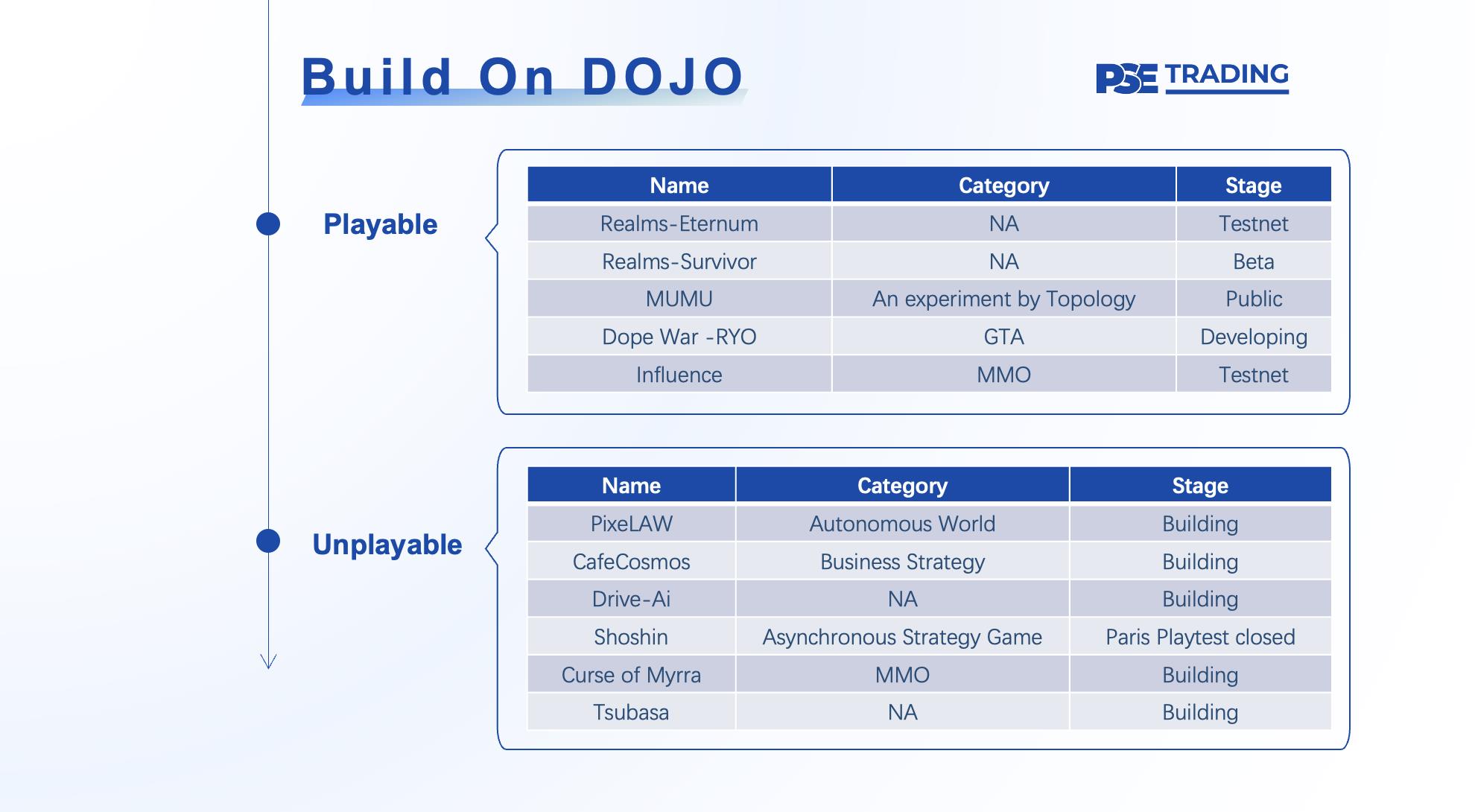
Overall, today’s engines are trying their best to improve the tick rate and expand the network in order to enable the blockchain to support more complex game interactions.
However, the biggest problem with fully chained game engines at present is the lack of unified construction standards. Referring to the development of web2 games, game engines have a strong Matthew effect, and there will only be 1-2 leading companies in the future, which will set the standards for the track.
According to the general development trend of the industry, the engine that finds the product-market fit (PMF) for fully chained game blockbusters will gain significant advantages in competition.
3.3 Communication Structure
There is a classic problem in traditional game development that is the relationship and hierarchical structure between different roles or objects in the game.
Take “aquatic creatures,” “terrestrial creatures,” and “amphibians” as examples. For aquatic creatures, they exist directly in the water layer, and the characteristics and behaviors related to the water environment can be relatively easily handled and realized. Similarly, terrestrial creatures can be directly placed in the land layer, and the functions related to the attributes and behaviors of the land environment can be relatively easily managed. However, amphibians, as a special case, need to survive and act in two different environments, which poses a problem. Placing amphibians in water or on land and how to switch between the two environments involve complex logic and interactions. Traditional module communication structures may encounter difficulties when dealing with this situation because they need to consider the transition and transformation between different environments, as well as the behavior and characteristics of amphibians in these environments.
To solve this problem, Web2 games have developed a framework called ECS, which stands for Entity-Component-System. ECS is a more flexible module communication structure that separates data (components) from behaviors (systems), making data storage and processing more flexible and efficient. For example, in the above example, using the ECS architecture allows amphibians to seamlessly switch between water and land and adjust their behavior and attributes automatically based on the current environment. This involves technologies such as state management, environment detection, and dynamic attribute changes.
Web3 games reference the ECS architecture and develop the Web3 Communication Infra-ARC, which stands for Action Registry Core. The technical core consists of three parts:
The object is an Action; in ARC, the core units of the game are treated as actions. This means that characters, events, decisions, etc., in the game are abstracted in the form of actions, making game interactions and logic more flexible and scalable.
Store only the game results on the chain;
Other data is stored offline and accessed through data indexers and data relay infrastructure.
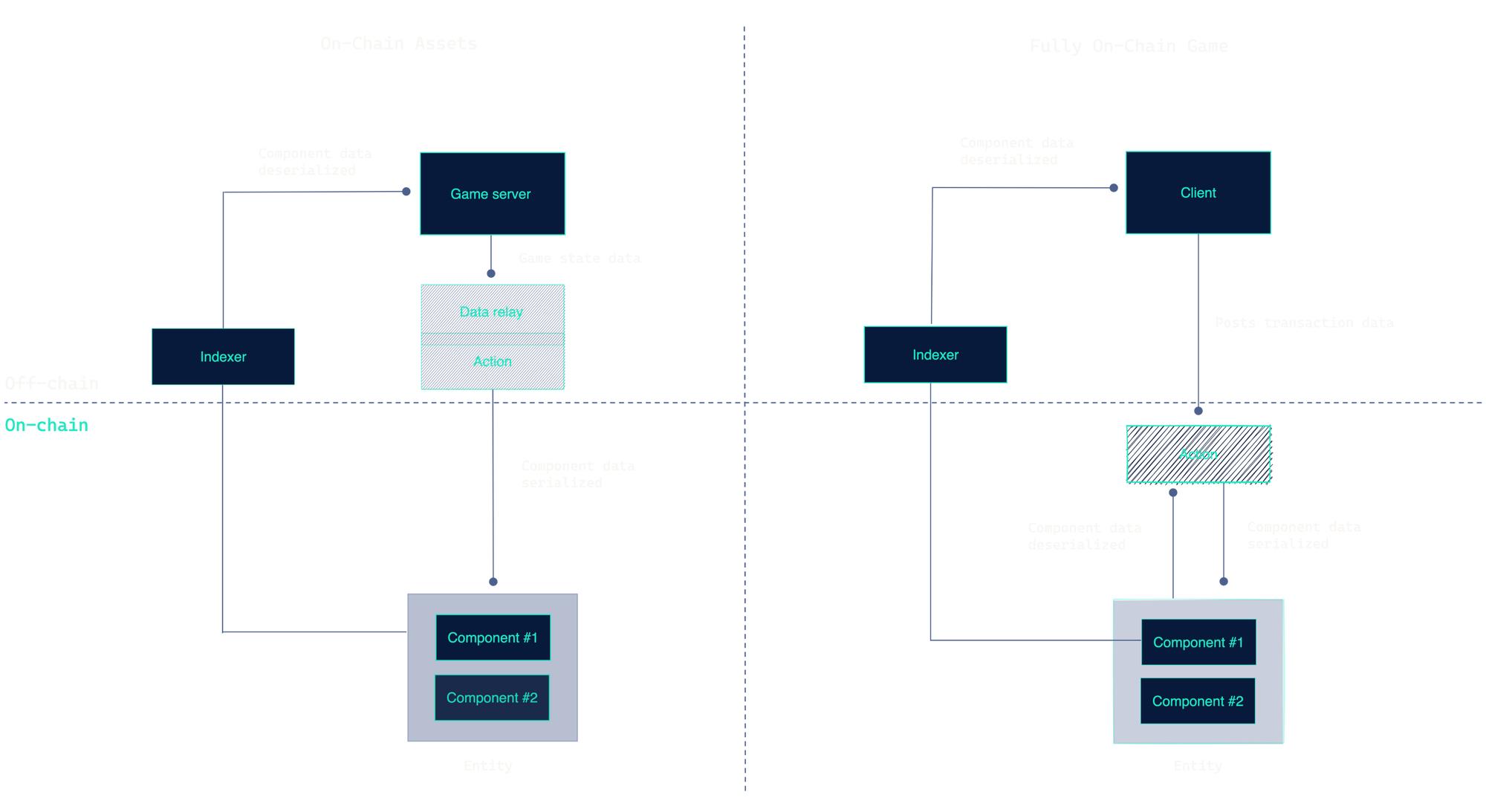
In summary, ARC, as the communication infrastructure in Web3 games, fully draws on the ideas of ECS architecture, providing higher flexibility, scalability, and efficiency for Web3 games through object-oriented actions, on-chain game results, and the integration of offline data and infrastructure.
Currently, there is no separate project developing the ARC communication structure, but major game engines and some independent Web3 game studios are committed to this.
3.4 Rendering Layer
The most famous rendering infrastructure in Web2 is Unreal Engine. In Web3, a distributed rendering protocol called RNDR is built by combining decentralized features.
The project behind RNDR is Render Network, a protocol that achieves distributed rendering using a decentralized network. The company behind Render Network, OTOY.Inc, was founded in 2009 and has optimized its rendering software, OctaneRender, for GPU rendering. For ordinary creators, local rendering consumes a lot of machine resources, which creates a demand for cloud rendering. However, renting servers from vendors such as AWS and Azure for rendering can be costly. This led to the creation of Render Network, which allows rendering without being limited by hardware conditions, connecting creators with ordinary users who have idle GPUs, enabling creators to render cheaply, quickly, and efficiently, and allowing node users to earn some pocket money by utilizing idle GPUs.
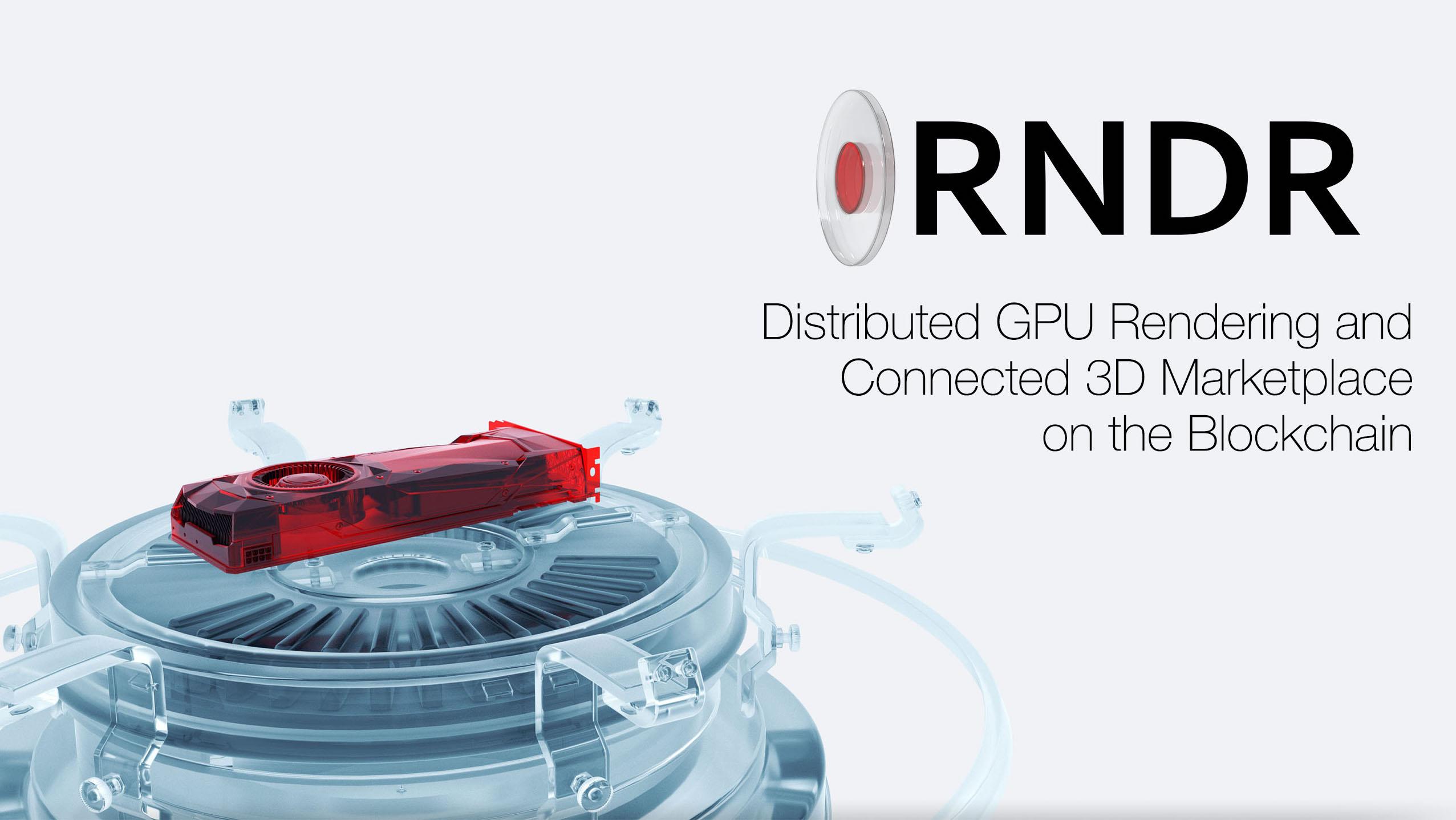
For Render Network, there are two types of participants:
• Creators: Initiate rendering tasks and purchase credits with fiat currency or RNDR for payment. (Octane X is the tool used to submit tasks, suitable for Mac and iLianGuaid. 0.5-5% of the fees will be used to cover network costs.)
• Node Providers (Owners of idle GPUs): Owners of idle GPUs can apply to become node providers and are determined to receive priority matching based on their reputation from previous completed tasks. When a node completes a rendering task, the creator will review the rendered file and initiate the download. Once the download is complete, the fees locked in the smart contract will be sent to the wallet of the node provider. This arrangement allows node providers to fully utilize their idle GPUs to earn additional income while improving the efficiency of the entire network.
In conclusion, Render Network, through its unique architecture, not only solves performance issues during rendering but also provides a win-win opportunity for creators and users with idle GPUs.
04 Middleware Layer
4.1 SDK Integration

Similar to Game Engine, SDK is provided to facilitate developers in deploying applications, but this type of SDK is targeted at more specific functions.
Project teams approach the integration of SDK from different angles. The following summarizes the three common GTM Strategies:
Case 01 – SDK Store
The first type is the SDK Store, similar to an app store, where project teams compile all the available SDKs in the market. Developers can then search for the SDKs they need directly in the SDK Store.
For example, Unity Asset Store provides verified SDKs from MetaMask, Magicblock (Solana), Tezos, Nefta, Immutable, and more. Web3.Unity from Chainsafe Gaming is also a popular open-source alternative outside of the Asset Store. Unreal Engine developers can consider Game7, Emergence, or Mirage’s Web3.Unreal.
Case 02 – Specialized Functions
SDKs targeting specific functions, such as:
NFT Market:
No-code solutions: Altura or Recur allow developers to create web-based external NFT markets without code.
In-game market: In-game markets have higher customization requirements. Existing solutions usually provide APIs or Unity/Unreal SDKs to simplify common market functions on the blockchain. These functions include listing NFTs, viewing inventory, or making purchases.
For example: Nefta, LianGuairticle Network, Venly, Sequence, Mirror World, Fungies, and Chainsafe Gaming.
In-game services:
There are also companies like Aqua that provide no-code/low-code in-game market as a service. By embedding the system directly into Unity game clients, players can access virtual markets, purchase decorations, character appearances, and other items within the game without leaving. Through integration with Unity, Aqua provides game developers with a simpler way to create rich in-game trading experiences for players.
In-game store system SDK:
Although not strictly in the gaming sector, there are also providers such as Ready Games and MetaFab that offer customized in-game store system SDKs/solutions.
4.2 One-stop Service Providers
One-stop service providers usually have the most comprehensive blockchain integration technology stack and offer related services to developers and publishers.
Case 01 – Forte
Forte is a blockchain gaming platform that provides a range of services aimed at building an accessible blockchain gaming ecosystem for developers, communities, and players. These services cover the entire lifecycle of game development, including liquidity, compliance, tool development, player services, game creation, and economic model design. Forte also offers funding for game creators to encourage game development.
In addition, Forte introduces DeFi and NFTs to create new revenue streams for game creators. Forte has established a market and trading service, simplifying the digital asset wallet experience and providing built-in compliance components such as AML and KYC. Through these features, Forte enables existing games to build scalable token economies, enhancing the sustainability and profitability of games.
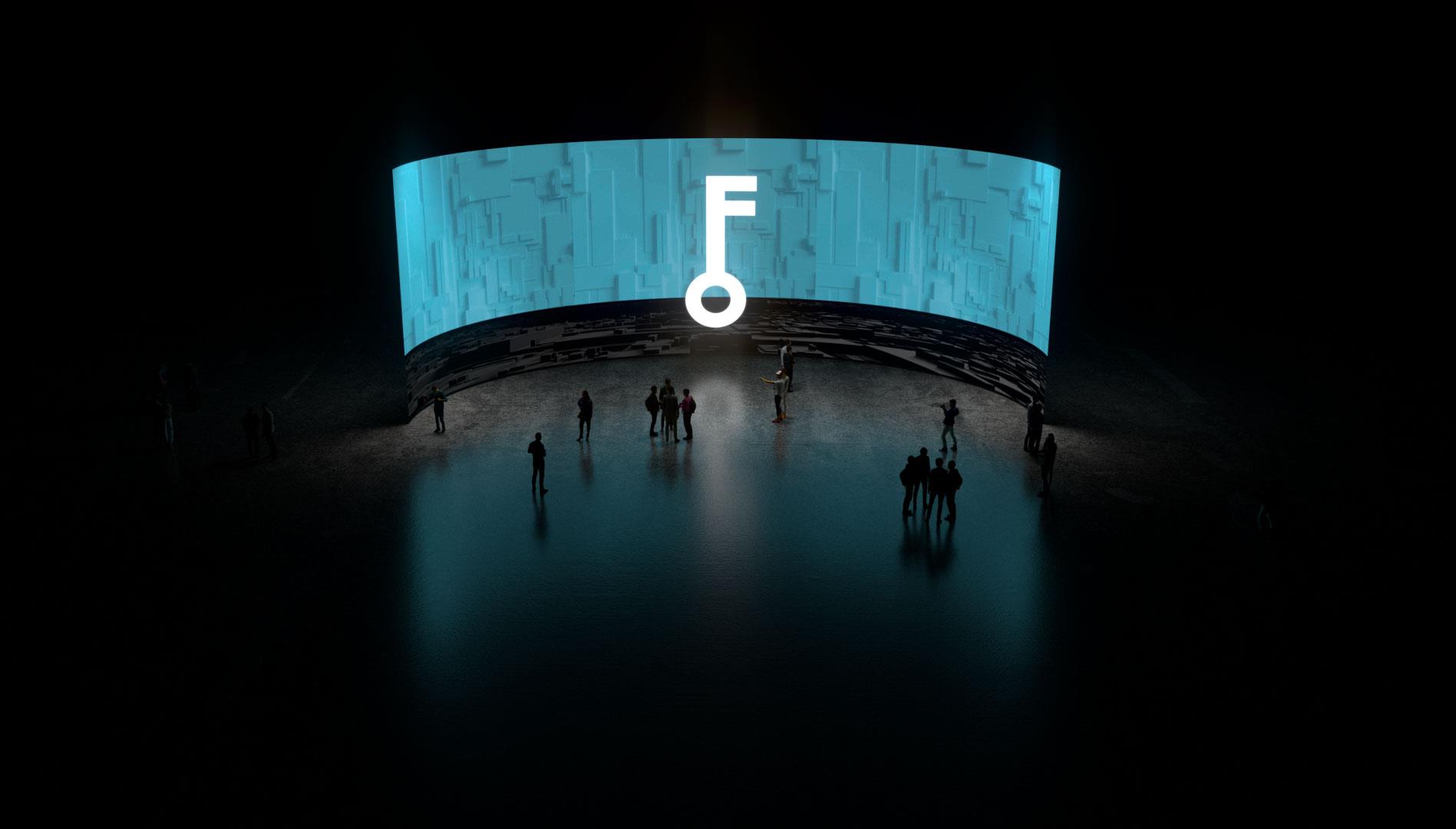
Case 02 – One-stop Consultation
Many game studios, such as Bigtime’s Open Loot and Horizon’s Sequence (skyweaver), offer consulting/incubation services. They leverage their rich experience to help Web 2 developers and games enter the market.
For example, in addition to technical integration, Open Loot also provides marketing support, payment processing, and comprehensive game analysis. Horizon’s Sequence helps Web 2 games transition to Web 3, including NFT-ization of virtual items and ownership transactions on the blockchain. These services not only expand the market but also help developers gain new business opportunities and growth in the digital field.
4.3 Communication Protocol
Case 01 – XMTP
XMTP is an early Web3 communication protocol project aimed at building a decentralized messaging system that provides communication infrastructure for all Dapps. It can be understood as a decentralized version of XMPP (Extensible Messaging and Presence Protocol) in the blockchain field. Using the built-in XMTP client, users can send and receive encrypted XMTP messages in applications and authenticate through wallet signatures. With this protocol, messages can be effectively encrypted and resistant to spam and other malicious behavior. However, the current protocol only supports point-to-point message delivery, i.e., it only supports one-to-one communication. Nevertheless, XMTP still lays a preliminary foundation for Web3 communication, making decentralized communication more practical and possible.

Case 02 – Web3MQ
Web3MQ is an open-source, decentralized, and secure communication protocol dedicated to becoming the native communication infrastructure for encryption. It extends and improves upon XMTP, providing an all-in-one communication solution that includes push, chat, and community functions.
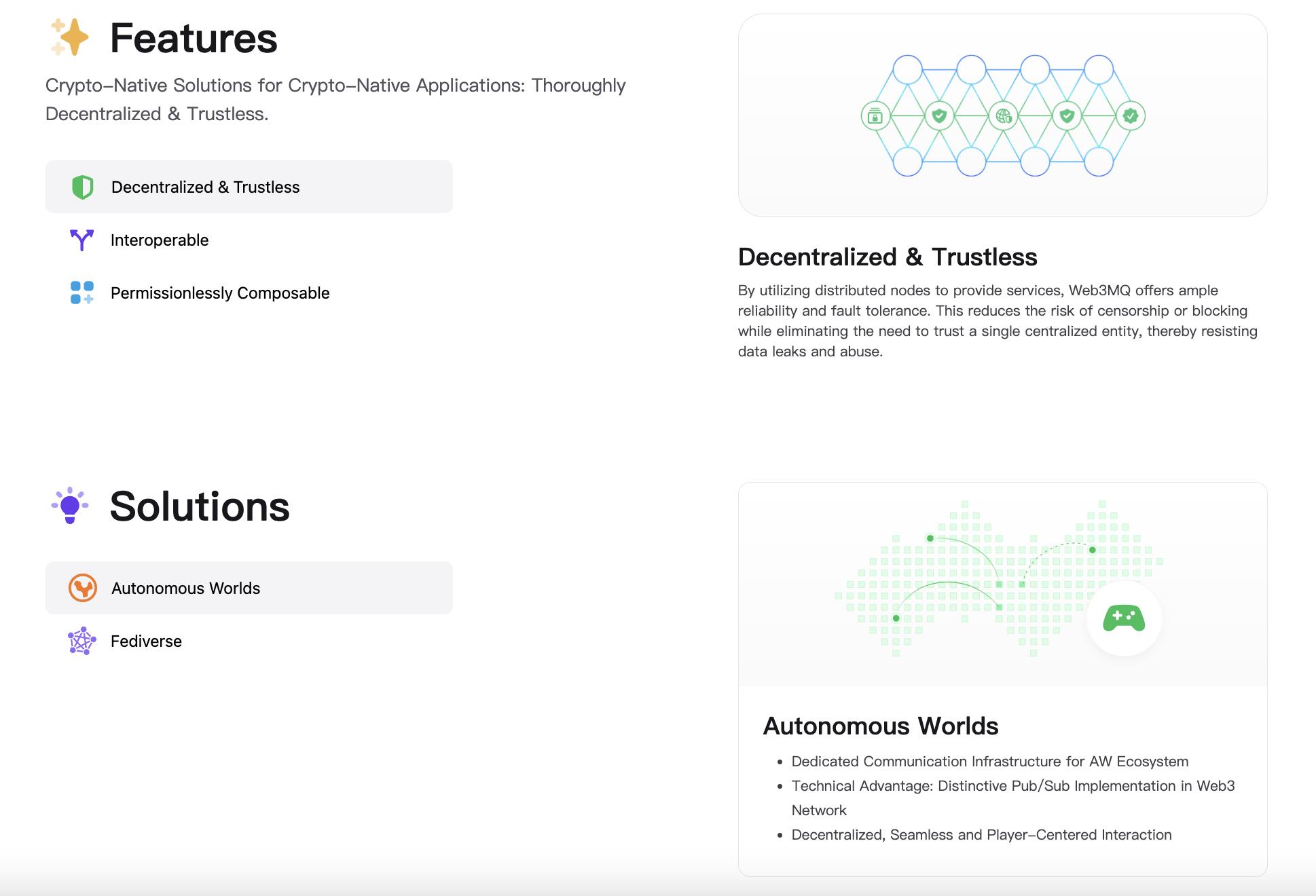
At the same time, Web3MQ is also compatible with a wide range of social identity and social graph protocols, using communication protocols as a bridge to unleash the potential of each social relationship. It also introduces existing Web3 ecosystems, including web3 storage (such as IPFS) and computation (such as Internet computers), as complements to the messaging ecosystem. Users can achieve higher levels of privacy protection and other personalized features through custom configurations. Compared to current web3 communication protocols, Web3MQ is a relatively mature and well-developed protocol project in terms of ideas and functionality.
4.4 Economic System Monitoring Tools
Most Web3 games have built-in economic systems, so monitoring the economic cycles is important for Web 3 games. This has led to the need for simulating, testing, and monitoring the health of gamefi systems.
Machinations provides game developers with a visual way to design and optimize the economic cycles of games. Currently, more than 20 Web 3 games have collaborated with Machinations to enhance the economic design of their games.
Specifically, let’s take a web 3 strategic game as an example. Players need to collect resources, build cities, and recruit troops. The resources in the game include wood, stone, and gold, and these resources interact with each other in the game, affecting players’ decisions and strategies. Using Machinations, game developers can create a chart to graphically represent factors such as resources, production, and consumption. They can set the speed at which resources are generated, the ways in which players use resources, and the relationships between resources. For example, developers can set wood and stone for building cities, and gold for recruiting troops. They can also set the costs of different actions, such as constructing new buildings, recruiting troops, or engaging in trade.
Through Machinations, developers can simulate the operation of the in-game economic system and see how the flow and changes of resources affect the entire game ecosystem. If a certain aspect is too scarce or excessive, developers can adjust the values to optimize the allocation of resources and make the game’s economic cycle more balanced and interesting.

4.5 Others
With the development of Web3 and blockchain technology, there are also some new protocols dedicated to deriving a small part of the game or certain functions of NFTs and empowering tokens within the game.
For example, Furion is mainly used to divide non-fungible tokens (NFTs) into corresponding ERC20 tokens, which can be freely traded and circulated on the Furion platform and support various financial operations such as lending, borrowing, leveraged long and short positions.
For example, let’s say an artist’s digital artwork is turned into an NFT, and the Furion platform can help divide this NFT into corresponding ERC20 tokens. These tokens can represent different parts or shares of the artwork and can be freely traded on the Furion platform. Art enthusiasts can purchase a portion of these ERC20 tokens, thereby sharing ownership of the digital artwork. In addition, Furion also supports financial operations such as lending, allowing users to invest and trade with the ERC20 tokens they hold.
This also provides new possibilities for the token model of GameFi. For example, GameFi can choose not to issue tokens directly, but to issue NFTs first, giving NFTs use cases, and then issue tokens based on NFTs as underlying assets.
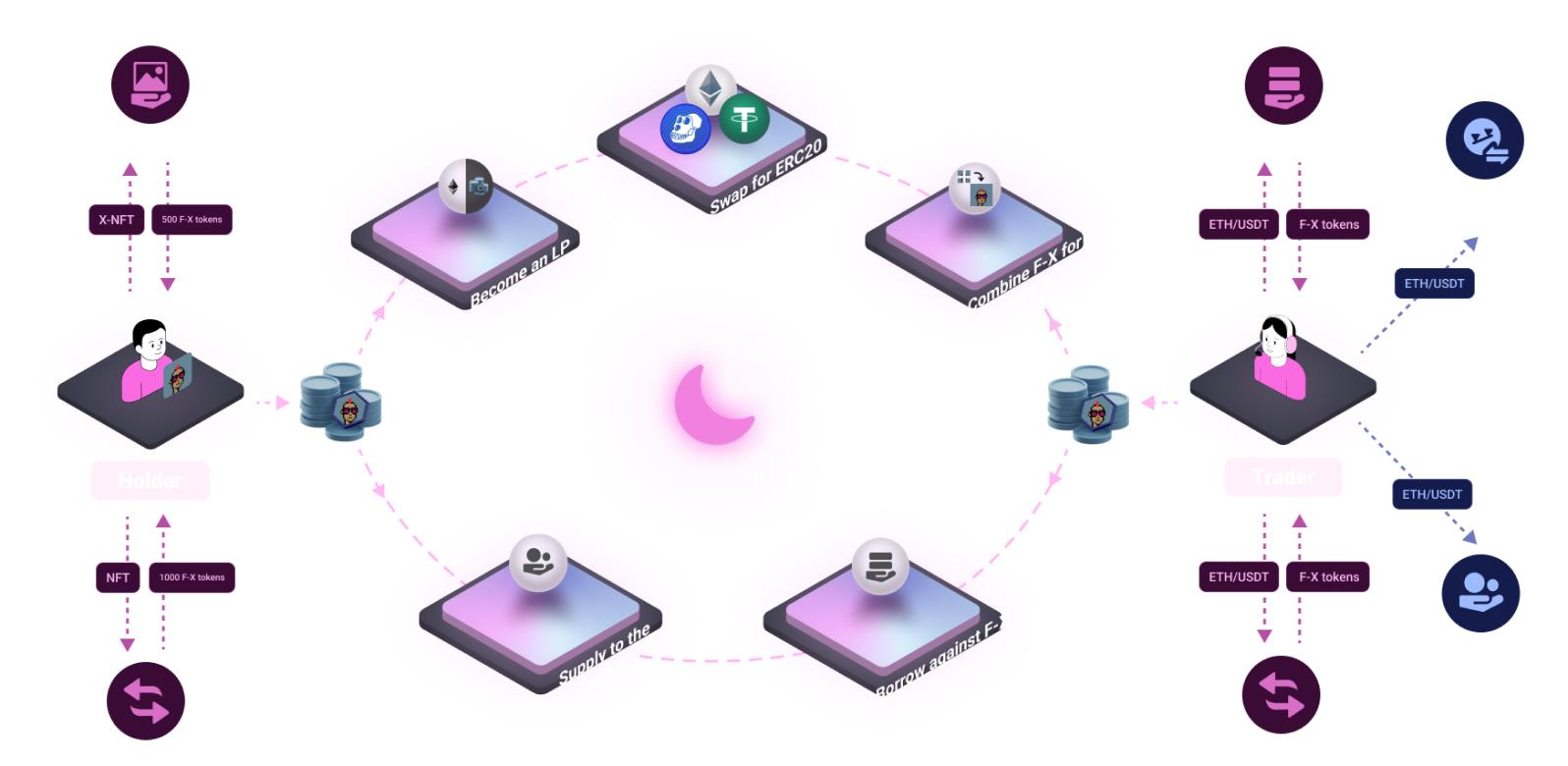
05 Channels / Distributors
In the gaming industry, channels and distributors play a crucial role. Looking back at game distribution in the Web 2.0 era, it can be divided into two main models.
First are game platform distributors such as Steam, Epic, Nintendo, etc., whose key success factor (KSF) is platform traffic. These distributors have risen to prominence with several popular games and unique well-known IPs. Continuous hit games have accumulated a large number of users for them, gradually transforming them from game developers to distribution platforms. They continue to expand their services, features, and social interactions, becoming comprehensive game platforms that further enhance user stickiness and build brand moats.
The second category consists of hardware and terminal manufacturers such as Huawei, Apple, etc., who still prioritize user traffic as their KSF. They attract users by launching high-quality devices and increasing device penetration. When users purchase and use the hardware, they not only get the hardware itself but also come into contact with the ecosystem and services provided by the platform, making them important game distribution channels.
Both game platform distributors and hardware/terminal manufacturers play important roles in the game industry. Through strategies such as accumulating user traffic, possessing well-known IPs, and building comprehensive ecosystems, these distributors have promoted the development of the game industry at different levels. Currently, a mature distribution channel system has not yet been formed in the Web3 field. The following summarizes several distribution strategies adopted in the Web3 game track in the current stage.
5.1 Path 1 – Classic Web2 Route
Its overall path is similar to Steam/Nintendo/TapTap in the Web2 era, aiming to become the TapTap of the Web3 field, relying on high-quality games to acquire user traffic and gradually develop into a distribution platform.
The advantage of this strategy is that it has been validated in the Web2 field. However, the disadvantages are also evident because the implementation of this model is quite heavy, requiring high funding and capabilities from the team. In addition, it is currently unclear who the first target audience for Web3 games is. The debate over whether to focus more on Web3 native users or to attract users from Web2 traffic has never stopped. This also makes the target audience of the distribution platform less clear, posing challenges to the team’s GTM (go-to-market) and product matrix.
Case 01 – XterioGames
XterioGames received a $15 million investment from Binance Labs in July 2023. Xterio is a Web3 game platform and publisher that is expected to release multiple cross-platform games on PC and mobile devices. The ecosystem will also distribute digital collectibles through Xterio’s network platform and marketplace.
For players, Xterio will provide a game gallery, NFT marketplace, on-chain operation interface, decentralized identity system, wallet, and community applications. For developers, Xterio offers solutions to alleviate the burden of on-chain programming, helping developers obtain funding and promotion, and creating a seamless path from development and launch to the ecosystem.
Overall, XterioGames is also a project continuously exploring Path 1. Xterio has several core games in development and has released several games through acquisitions and collaborations. The following image shows some of the games already released by XterioGames.

Case 02 – Cartridge
Cartridge is a Starknet ecological game integration platform, positioned as the Web3 Steam.
For developers, Cartridge has launched the Cartridge Controller and Dojo Engine, which simplify the development process and reduce the development threshold through a unified framework. For players, they can quickly find games on Cartridge. Currently, Cartridge has provided several playable games. The following figure only shows some playable games.
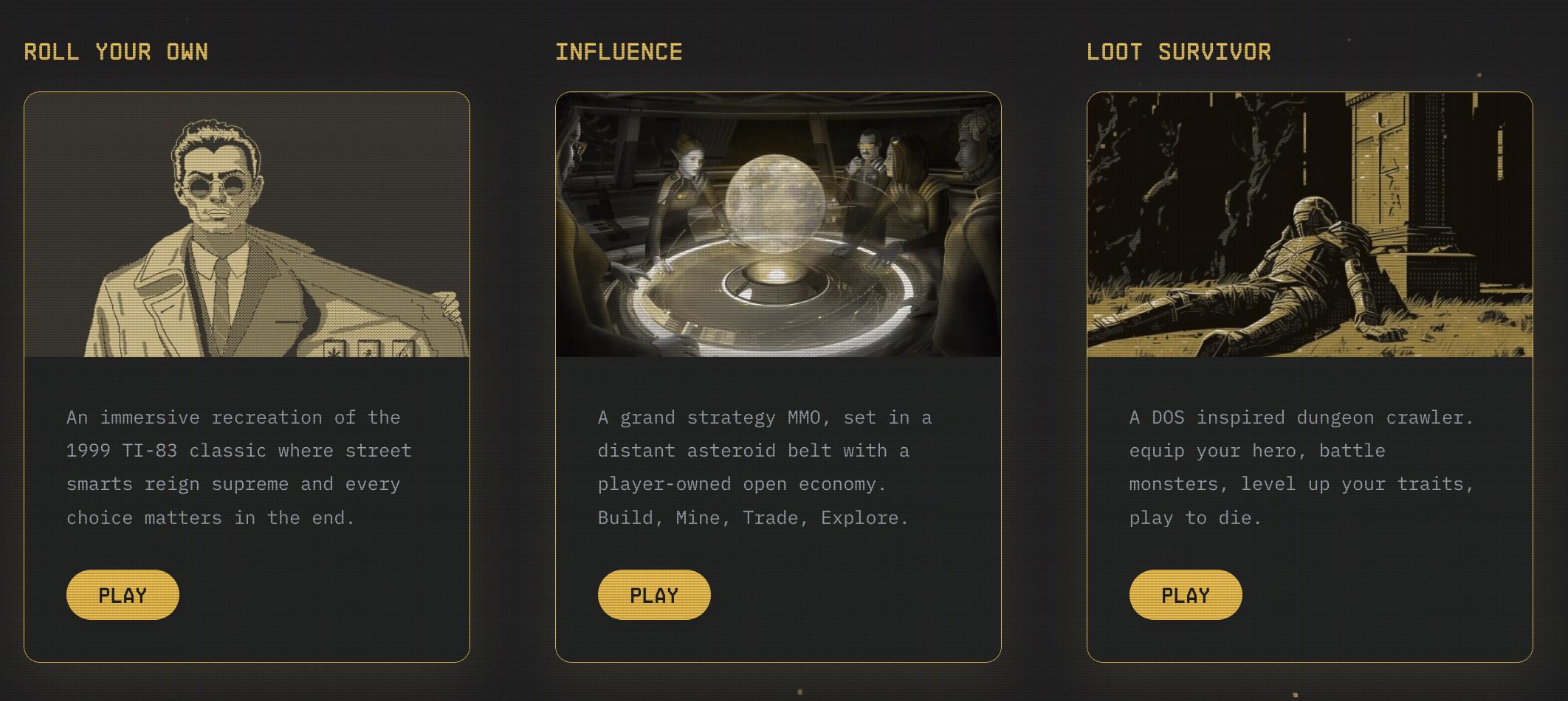
Case 03 – Createra
Createra is a user-generated content (UGC) meta-verse engine invested by a16z, enabling creators to create, distribute, and MetaFi games. Createra provides users with a unique encrypted native autonomous world, including cross-play and instant access. In addition, everything built on the platform’s land is tradable, including models, games, APIs, etc. The project also focuses on integrating ERC-6551 with games, such as in the decentralized identity (DID) field.
Overall, Createra can be seen as the Web3 version of Minecraft to some extent. By partnering with popular IPs such as BAYC, it encourages Web3 users to enter the gaming world, create personal virtual environments, and interact in the entire ecosystem. The project continues to add more features and services to the ecosystem, such as mapping players’ achievements to DID or embedding other games in the world, making it a gamified comprehensive distribution platform.
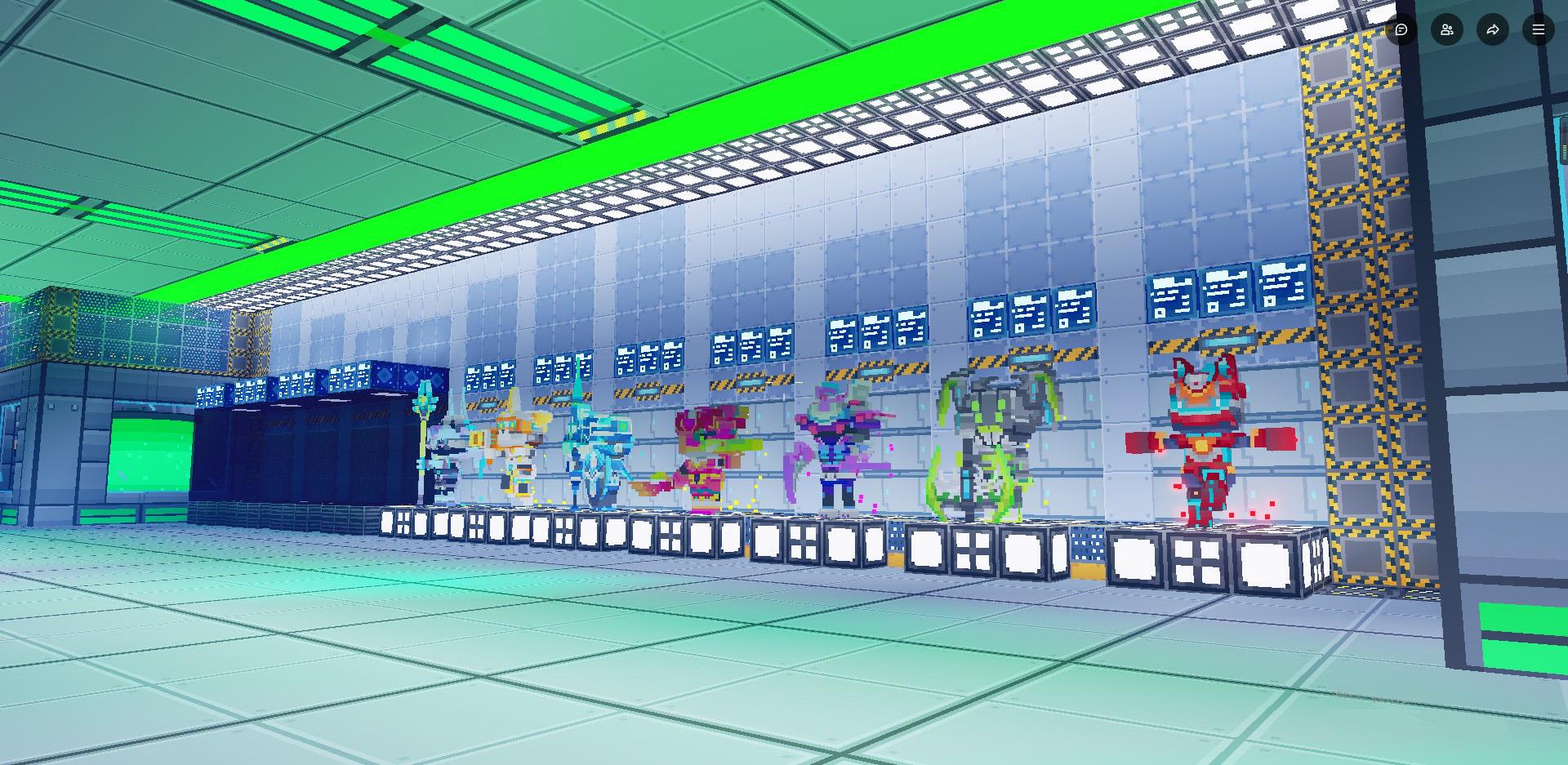
5.2 Road 2 – Exploration of Crypto Native
Road 2 is a more Crypto Native exploration, gathering users through player interaction and becoming a focus of traffic. Currently, there are many attempts in this field exploration, including building achievement systems, aggregating airdrops, creating education systems, and building decentralized identities (DID), etc.
Compared with Road 1, Road 2 is more Crypto Native, with a lighter mode and lower requirements for the team’s financial strength, but higher requirements for the team’s user operation capabilities. In this route, the team needs to have the ability to quickly capture the most interesting interaction methods for Web3 users and timely integrate these trends into their own platform, thus achieving effective user flow.
However, it is worth noting that the exploration of Road 2 has not been fully market validated. Among different development paths, which one is the ultimate choice of the market still has a high degree of uncertainty. Therefore, the team needs to maintain keen market insights, constantly adjust strategies to adapt to market changes, and closely monitor the changing trends of user needs. The following summarizes some relevant cases of choosing Road 2.
Case 01 – Carv
Carv is a GameID platform that starts from the achievement system. Interestingly, it calculates the user’s reputation score based on the user’s past on-chain data. The overall presentation of the GameID is also based on this reputation score + the received SBT. The platform verifies the achievements reached by the user through fetching on-chain data and allows the user to claim the corresponding Soul Token (SBT) when the conditions are met.
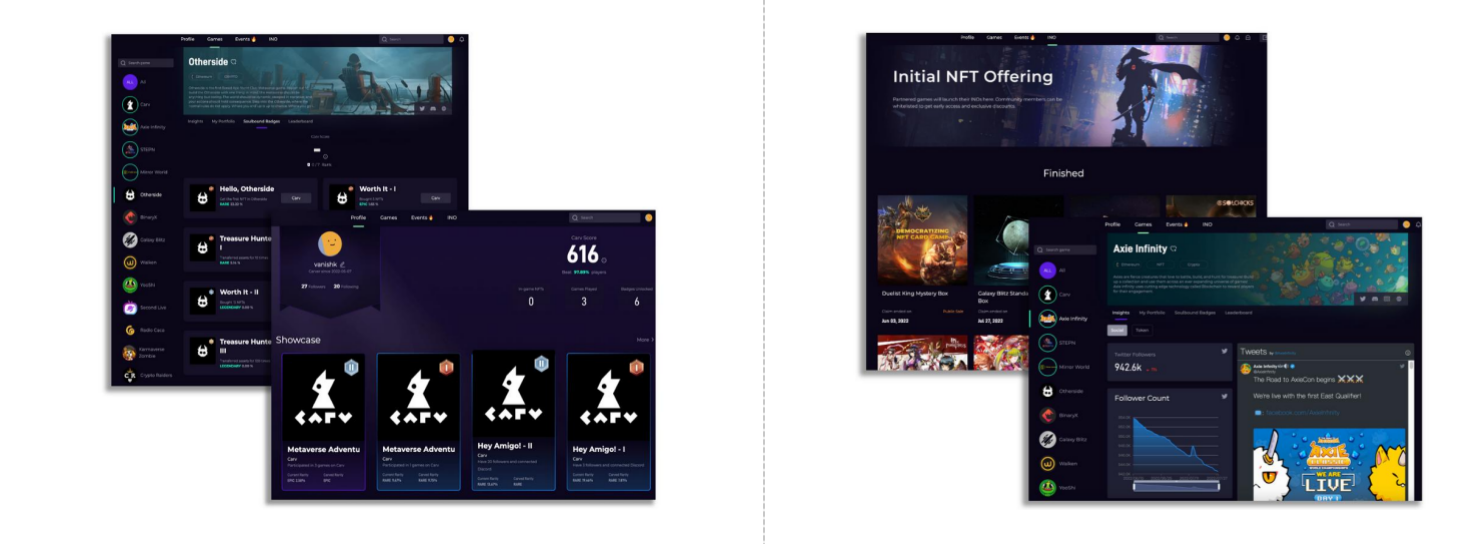
The platform provides a social data analysis for listed projects, allowing players to quickly discover games with potential and high popularity. It also allows players to track the latest social dynamics of games they are interested in, which is very helpful for players. The platform also has an INO section, which allows games to launch NFTs. However, this part relies more on the BD capabilities of the project party. So far, there have only been 10 issuances.
Case 02 – DeQuest
DeQuest is a GameID platform that starts from the quest system. It has gamified designs, presenting the user’s GameID in the form of virtual images (which can be used to enter the sandbox in the future). During the process of completing quests, users can unlock equipment and skills.

Case 03 – LianGuairami
LianGuairami Protocol is an ERC5489 protocol that can revolutionize the creator economy of the internet, turning NFTs into gateways for web3 content discovery. For example, suppose there is a social media platform where users can upload their social data, posts, photos, and other information to the blockchain using LianGuairami Protocol. These data will be securely stored and encrypted. Users can authorize other users or institutions to access and use this data with permission.
In addition to applications in data sharing and privacy protection, LianGuairami Protocol actively collaborates with many game projects, creating broader possibilities for users. For example, a game based on LianGuairami Protocol can allow players to map their achievements and ownership of items in the game to NFTs, thus achieving richer asset value transfer and interaction in the web3 ecosystem. This collaboration elevates the gaming experience to a whole new level and connects the virtual world with the real world more closely.
In summary, while LianGuairami Protocol is pioneering new ways of data governance and content discovery, it also provides possibilities to become a gateway for traffic in the gaming track.

5.3 Road Three – Public Chain and Exchange Incubation
In the Web2 ecosystem, many content providers (CPs), such as game developers, usually pay fees to distribution platforms to obtain traffic and exposure on the platforms. However, in the Web3 ecosystem, due to the lack of high-quality content, there is a phenomenon of platforms paying high-quality CPs. More specifically, hackathons organized by some public chains and exchanges are typical examples. In these events, outstanding content creators are selected and provided with resources and training support, encouraging the emergence of more high-quality content in their own public chain/exchange ecosystems, thereby promoting the development of the entire ecosystem.
For example, Stepn, the leading Gamefi project in 2021, is a typical case. Referring to the speech by Stepn Co-Founder SLianGuaice, a crucial step from 0 to 1 was winning the Solana hackathon, which boosted team morale and provided initial resources.
Currently, many public chains and exchanges are organizing hackathon events, and some even collaborate to incubate projects. This provides excellent opportunities for the development of the industry and outstanding projects.
Conclusion
This article focuses on the concept of the full-chain game and the presentation of the value chain panorama, aiming to provide readers with a clearer understanding of the various aspects of the full-chain game industry. Subsequent articles in the PSE Trading series will explore the full-chain game from different perspectives in more detail.
We will continue to update Blocking; if you have any questions or suggestions, please contact us!
Was this article helpful?
93 out of 132 found this helpful
Related articles
- How to Report Being Scammed When Buying USDT Virtual Currency, Lawyer Teaches You
- Blockchain User Activity Survey Ethereum Still Reigns, Who is Using Litecoin and Tron?
- Trillion-level business opportunity In-depth analysis of the prospects of security tokens in Hong Kong
- Unable to guard against Why are a large number of encrypted Twitter accounts hacked and used to publish phishing links? How to prevent it?
- Tornado Cash founder arrested, what original sin did the mixer commit?
- Why are Layer2 tokens not used for paying network GAS?
- Is an encrypted market maker the ‘behind-the-scenes dealer’?




